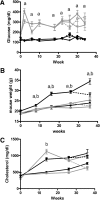Reversibility of renal injury with cholesterol lowering in hyperlipidemic diabetic mice
- PMID: 20110440
- PMCID: PMC3035509
- DOI: 10.1194/jlr.M002972
Reversibility of renal injury with cholesterol lowering in hyperlipidemic diabetic mice
Abstract
Hyperlipidemia is a risk factor for development and progression of diabetic nephropathy. However, it is not known if reduction of hyperlipidemia is protective against progression of disease. The goal of this study was to determine if reduction of hypercholesterolemia could limit progression of diabetic nephropathy. Diabetic and nondiabetic LDL receptor deficient (LDLR(-/-)) mice were fed diets containing either no cholesterol (0%) or high cholesterol (0.12%) for 36 weeks. One group each of diabetic and nondiabetic mice were fed the high-cholesterol diet for 26 weeks then changed to the 0% cholesterol diet for the last 10 weeks. Consumption of the high-cholesterol diet exacerbated the development of diabetic nephropathy with elevations in urine albumin excretion, glomerular and renal hypertrophy, and mesangial matrix expansion. Increased glomerular lipid and apolipoprotein B accumulation was found in diabetic mice that consumed the 0.12% cholesterol diet compared with other groups. However, diabetic mice that changed from the high-cholesterol diet to the 0% cholesterol diet for the last 10 weeks had lower urine albumin excretion and mesangial matrix expansion compared with mice that consumed the 0.12% cholesterol diet throughout. This suggests that hyperlipidemia causes continuous renal injury, and that lowering cholesterol levels by dietary means can improve renal function in diabetic LDLR(-/-) mice.
Figures



Similar articles
-
Renal accumulation of biglycan and lipid retention accelerates diabetic nephropathy.Am J Pathol. 2011 Sep;179(3):1179-87. doi: 10.1016/j.ajpath.2011.05.016. Epub 2011 Jun 30. Am J Pathol. 2011. PMID: 21723246 Free PMC article.
-
Hyperglycemia and hyperlipidemia act synergistically to induce renal disease in LDL receptor-deficient BALB mice.Am J Nephrol. 2004 Jan-Feb;24(1):20-31. doi: 10.1159/000075362. Epub 2003 Dec 10. Am J Nephrol. 2004. PMID: 14671436
-
Severe hypertriglyceridemia and hypercholesterolemia accelerating renal injury: a novel model of type 1 diabetic hamsters induced by short-term high-fat / high-cholesterol diet and low-dose streptozotocin.BMC Nephrol. 2015 Apr 11;16:51. doi: 10.1186/s12882-015-0041-5. BMC Nephrol. 2015. PMID: 25884847 Free PMC article.
-
Lipids, protein intake, and diabetic nephropathy.Diabetes Metab. 2000 Jul;26 Suppl 4:45-53. Diabetes Metab. 2000. PMID: 10922973 Review.
-
Renal protection and antihypertensive drugs: current status.Drugs. 1999 May;57(5):665-93. doi: 10.2165/00003495-199957050-00002. Drugs. 1999. PMID: 10353294 Review.
Cited by
-
Early systemic microvascular damage in pigs with atherogenic diabetes mellitus coincides with renal angiopoietin dysbalance.PLoS One. 2015 Apr 24;10(4):e0121555. doi: 10.1371/journal.pone.0121555. eCollection 2015. PLoS One. 2015. PMID: 25909188 Free PMC article.
-
Apolipoprotein B and renal function: across-sectional study from the China health and nutrition survey.Lipids Health Dis. 2020 May 27;19(1):110. doi: 10.1186/s12944-020-01241-7. Lipids Health Dis. 2020. PMID: 32460759 Free PMC article.
-
Prevention of renal apoB retention is protective against diabetic nephropathy: role of TGF-β inhibition.J Lipid Res. 2017 Dec;58(12):2264-2274. doi: 10.1194/jlr.M078204. Epub 2017 Sep 14. J Lipid Res. 2017. PMID: 28912302 Free PMC article.
-
Combining streptozotocin and unilateral nephrectomy is an effective method for inducing experimental diabetic nephropathy in the 'resistant' C57Bl/6J mouse strain.Sci Rep. 2018 Apr 3;8(1):5542. doi: 10.1038/s41598-018-23839-9. Sci Rep. 2018. PMID: 29615804 Free PMC article.
-
An ACACB variant implicated in diabetic nephropathy associates with body mass index and gene expression in obese subjects.PLoS One. 2013;8(2):e56193. doi: 10.1371/journal.pone.0056193. Epub 2013 Feb 27. PLoS One. 2013. PMID: 23460794 Free PMC article.
References
-
- Kamanna V. S., Pai R., Roh D. D., Kirschenbaum M. A. 1996. Oxidative modification of low-density lipoprotein enhances the murine mesangial cell cytokines associated with monocyte migration, differentiation, and proliferation. Lab. Invest. 74: 1067–1079. - PubMed
-
- Pai R., Kirschenbaum M. A., Kamanna V. S. 1995. Low-density lipoprotein stimulates the expression of macrophage colony-stimulating factor in glomerular mesangial cells. Kidney Int. 48: 1254–1262. - PubMed
-
- Chana R. S., Wheeler D. C., Thomas G. J., Williams J. D., Davies M. 2000. Low-density lipoprotein stimulates mesangial cell proteoglycan and hyaluronan synthesis. Nephrol. Dial. Transplant. 15: 167–172. - PubMed
-
- Kamanna V. S. 2002. Low density lipoproteins and mitogenic signal transduction processes: role in the pathogenesis of renal disease. Histol. Histopathol. 17: 497–505. - PubMed
-
- Lee H. S., Kim B. C., Hong H. K., Kim Y. S. 1999. LDL stimulates collagen mRNA synthesis in mesangial cells through induction of PKC and TGF-beta expression. Am. J. Physiol. 277: F369–F376. - PubMed
Publication types
MeSH terms
Substances
Grants and funding
LinkOut - more resources
Full Text Sources
Other Literature Sources
Medical
Molecular Biology Databases

